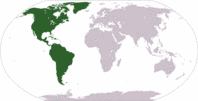Euterpe broadwayi
| Euterpe (yoo-TEHR-peh) broadwayi (broad'-weigh) | |||||||
|---|---|---|---|---|---|---|---|
 Euterpe broadwayi in Guadeloupe. Photo-Tipalm.fr | |||||||
| Scientific Classification | |||||||
| |||||||
| Synonyms | |||||||
|
| |||||||
| Native Continent | |||||||
|
| |||||||
| Morphology | |||||||
| |||||||
| Culture | |||||||
|
| |||||||
| Survivability index | |||||||
|
| |||||||
| Common names | |||||||
|
| |||||||
Contents
Habitat and Distribution
Trinidad-Tobago, Windward Is. Lesser Antilles (Dominica, Grenada, St. Vincent), Trinidad, and Tobago; exposed, wind-swept places on forested mountain ridges or steep river valleys; alt. 600-1000 m.Description
Stems caespitose (growing in tufts or clumps) with 2-3 stems, seldom solitary, erect or slightly leaning, 8-20 m tall, 20-25 cm in diam., gray, with a cone of roots at base, these to 2 m long. Leaves 10-16 in the crown, spreading; sheath 1.3-1.8 m long, green or reddish brown; petiole 0.7-1.2 m long, densely to moderately covered with flat, irregular, black, reddish brown, or whitish brown scales; rachis 2.9-3.6 m long, with scales like those of petiole; pinnae 80-92 per side, pendulous to horizontal but pendulous at the apices, subopposite, coriaceous, scaly near point of insertion, with numerous punctations abaxially, with prominent mid vein and 2 lateral veins either side, the midvein with prominent brown ramenta abaxially; basal pinna 70-80 x 0.7 cm; middle pinnae 0.8-1.2 m x 3-4.5 cm; apical pinna 30-50 x 0.8-1 cm. Inflorescences infrafoliar, ± horizontal at anthesis; peduncle 15-20 cm long, about 3 cm in diam.; prophyll about 1.3 m long; peduncular bract about 1.2 m long; rachis about 45 cm long; rachillae about 95, 70-95 cm long, 0.7-1 cm in in diam. at anthesis, absent from adaxial, basal part of rachis , densely covered with 1-2 mm long, branched, intertwined, whitish brown hairs; flowers in triads for ca. 2/3 of the rachillae, paired or solitary staminate distally; triad bracteole prominent, deltate, to 3 mm long, covered with hairs abaxially; first flower bracteole obscure, irregular, 1 mm long, second and third flower bracteoles prominent, ± equal, rounded, 2 mm long, covered in hairs abaxially; staminate flowers to 5 mm long; sepals widely ovate, 3 mm long, broadly imbricate, membranous, ciliate; petals ovate, 3.5-4 mm long, fleshy; stamens arranged on a short receptacle; filaments 1.5 mm long, flattened; anthers 2.5 mm long; pistillode 1.5-3 mm long, deeply trifid at apex; pistillate flowers to 4 mm long; sepals very widely ovate, 4 mm long; petals very widely ovate. 4 mm long. Fruits globose or depressed globose, 1-1.4 cm in diam., the stigmatic remains subapical to lateral; epicarp purpleblack, minutely tuberculate; seeds globose; endosperm homogeneous; eophyll palmate. (Gloria Galeano and A. Henderson)/Palmweb. Editing by edric.
There is some variation in indument. Leaves of specimens from Trinidad are the most scaly, ramenlose, and punctate, and the leaves have a dense covering of black scales; specimens from Tobago and the Lesser Antilles are less scaly, ramentose, and punctale, and the leaves have whitish brown scales. It is interesting that three species of Euterpe (E. broadwayi, E. oleracea, and E. precatoria) occur on the small island of Trinidad, and remarkable that E. broadwayi has not been found in Venezuela [although Wessels Boer (1988) believed it may occur there]. This species has an unusual distribution for a palm; two other species, Syagrus amara (Jacquin) Martius and Aiphanes minima (Gaertner) Burret, have somewhat similar distributions. (Gloria Galeano and A. Henderson)/Palmweb.
Culture
Cold Hardiness Zone: 10b
Comments and Curiosities
Euterpe broadwayi in Guadeloupe: (formerly E. dominicana). Abundant on the neighboring island of Dominica, located between the two French departments, this palm is very rare among us. On Martinique, only a very few grow, including the Morne Morne Lorrain and Jacob, in the northern and mountainous island, never below 400 m altitude. In Guadeloupe, several stations are now known, such as on a mountainside called "Mama Petit-Bourg" in the valley of Carbet, near the second fall, and the Moreau River valley. This is a palm unrecognized, yet beautiful, one of the largest and most beautiful that populate the Lesser Antilles. It has large leaves and regular leaflets drooping, gushing at the end of a long white petiole, extended smooth and straight trunk, ringed in its upper part. In response to a steep and extremely humid environment, it develops a cone of adventitious roots bright red, very characteristic. (Gloria Galeano and A. Henderson)/Palmweb.
Uses: The palm heart is eaten, and is in much demand in some places.
- IMAGE GALLERY
External Links
References
Phonetic spelling of Latin names by edric.
Special thanks to Geoff Stein, (Palmbob) for his hundreds of photos.
Special thanks to Palmweb.org, Dr. John Dransfield, Dr. Bill Baker & team, for their volumes of information and photos.
Glossary of Palm Terms; Based on the glossary in Dransfield, J., N.W. Uhl, C.B. Asmussen-Lange, W.J. Baker, M.M. Harley & C.E. Lewis. 2008. Genera Palmarum - Evolution and Classification of the Palms. Royal Botanic Gardens, Kew. All images copyright of the artists and photographers (see images for credits).
Gloria Galeano & A. Henderson. Flora Neotropica. New York Botanical Garden.
Many Special Thanks to Ed Vaile for his long hours of tireless editing and numerous contributions.

































